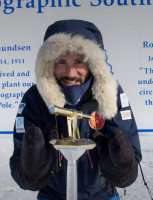Climate & Environment
Terrestrial Biodiversity
Climate Change
Trees, Forests & Deforestation
Climate Adaptation & Resilience
Carbon Cycle
Nature-based Solutions
Post-Doctoral Fellowships
France
2008.10.31
Palaeoecology, environmental risks on forest ecosystems
Biography
I graduated from University of Pisa (Italy) in 1998 where I studied surface landforms (fossil moraines, rock glaciers) at high-elevation in the Franco-Italian Maritime Alps. After a short break due to the alternative Civilian Service at a Natural Park near Pisa, I pursued my research interests in palaeoecology at the University of Bern (Switzerland) first with a grant from the Bern Canton and subsequently with a PhD grant. I moved later to Utrecht (The Netherlands) as a post-doctoral researcher where I undertook research focusing on different topics, including (i) quantitative climate reconstructions of the past using pollen records, (ii) plants’ response to CO2 changes during the past 1000 years, (iii) biotic responses to climate change, changes in land-use activities, and fire regimes.
Research work
Boreal forests (i.e. conifer forests around the Arctic Circle) and European-mountain forests are both tamed to a significant fire-risk increase in response to current climatic changes. The quantification of risk resulting from fire is crucial for the sustainable management of those forests, which are rich in natural woody resources. In fact, although boreal forests account for only ca. ⅓ of the worlds’ forests, they supply ca. 90% of the worlds’ paper and timber industry. Boreal forests are also a major societal issue in terms of terrestrial carbon storage because these forests act as long-term carbon reservoirs (carbon accumulates in organic soils and in peat) but they also can contribute to carbon fluxes from biomass to the atmosphere during natural disturbances (fire, insect disease) or human activities (industrial logging).
In order to formulate a risk assessment and predict potential fire outbreaks due to future climate changes, it is essential to understand the processes influencing fire-frequency changes. At present two alternative hypotheses are under debate: (i) climatic changes act directly on fire frequency without initial modification of the vegetation composition, and (ii) climate changes trigger plant-cover changes that alter the fire frequency through fuel modification. My aim is to test whether changes in fire frequencies are linked to plant-cover changes, both in terms of vegetation type and diversity. Because processes acting on ecosystems cannot be deciphered solely by the observations and monitoring of modern ecosystems (‘short’ timescale of decades), I will use fossil records of vegetation and fire-frequency changes to conduct long-term observations (longer timescales of several millennia).
Observations will be conducted in Canada because human activities have had a low impact in that region and will, therefore, not mask natural processes. In practice I will use lake sediments that accumulated over the past ca. 10,000 years as natural archives for microfossils (pollen grains and charcoal particles). The quantification of these microfossils at different depths along lake-sediment cores allows the reconstruction of past changes in vegetation composition and of fire frequencies. By dating the sediments with radiocarbon at different depths it is possible to assign precise ages to each analysed sample.
Canadian boreal forests are very similar to European mountain forests both in terms of plant species/genera and ecological services. This research will, therefore, also contribute to the quantification of risk resulting from disturbances in Europe, where the density of territories covered by fire-susceptible forests is increasing due to land-use abandonment and rural exodus from mountain regions since the end of the 19th century.
AXA funding
The funding provided by the AXA Research Fund is essential for this research, which will be conducted in collaboration with an international (French-Canadian) research consortium. Therefore, the funding gives me also the opportunity to get into contact with several scientists, to exchange ideas with them, and to contribute to their ongoing projects (e.g. CLIMAFEUX, RESILIENCE) with my work. It will help to pursue my research interests that aim to a better (sustainable) management of ecosystems.
I graduated from University of Pisa (Italy) in 1998 where I studied surface landforms (fossil moraines, rock glaciers) at high-elevation in the Franco-Italian Maritime Alps. After a short break due to the alternative Civilian Service at a Natural Park near Pisa, I pursued my research interests in palaeoecology at the University of Bern (Switzerland) first with a grant from the Bern Canton and subsequently with a PhD grant. I moved later to Utrecht (The Netherlands) as a post-doctoral researcher where I undertook research focusing on different topics, including (i) quantitative climate reconstructions of the past using pollen records, (ii) plants’ response to CO2 changes during the past 1000 years, (iii) biotic responses to climate change, changes in land-use activities, and fire regimes.
Research work
Boreal forests (i.e. conifer forests around the Arctic Circle) and European-mountain forests are both tamed to a significant fire-risk increase in response to current climatic changes. The quantification of risk resulting from fire is crucial for the sustainable management of those forests, which are rich in natural woody resources. In fact, although boreal forests account for only ca. ⅓ of the worlds’ forests, they supply ca. 90% of the worlds’ paper and timber industry. Boreal forests are also a major societal issue in terms of terrestrial carbon storage because these forests act as long-term carbon reservoirs (carbon accumulates in organic soils and in peat) but they also can contribute to carbon fluxes from biomass to the atmosphere during natural disturbances (fire, insect disease) or human activities (industrial logging).
In order to formulate a risk assessment and predict potential fire outbreaks due to future climate changes, it is essential to understand the processes influencing fire-frequency changes. At present two alternative hypotheses are under debate: (i) climatic changes act directly on fire frequency without initial modification of the vegetation composition, and (ii) climate changes trigger plant-cover changes that alter the fire frequency through fuel modification. My aim is to test whether changes in fire frequencies are linked to plant-cover changes, both in terms of vegetation type and diversity. Because processes acting on ecosystems cannot be deciphered solely by the observations and monitoring of modern ecosystems (‘short’ timescale of decades), I will use fossil records of vegetation and fire-frequency changes to conduct long-term observations (longer timescales of several millennia).
Observations will be conducted in Canada because human activities have had a low impact in that region and will, therefore, not mask natural processes. In practice I will use lake sediments that accumulated over the past ca. 10,000 years as natural archives for microfossils (pollen grains and charcoal particles). The quantification of these microfossils at different depths along lake-sediment cores allows the reconstruction of past changes in vegetation composition and of fire frequencies. By dating the sediments with radiocarbon at different depths it is possible to assign precise ages to each analysed sample.
Canadian boreal forests are very similar to European mountain forests both in terms of plant species/genera and ecological services. This research will, therefore, also contribute to the quantification of risk resulting from disturbances in Europe, where the density of territories covered by fire-susceptible forests is increasing due to land-use abandonment and rural exodus from mountain regions since the end of the 19th century.
AXA funding
The funding provided by the AXA Research Fund is essential for this research, which will be conducted in collaboration with an international (French-Canadian) research consortium. Therefore, the funding gives me also the opportunity to get into contact with several scientists, to exchange ideas with them, and to contribute to their ongoing projects (e.g. CLIMAFEUX, RESILIENCE) with my work. It will help to pursue my research interests that aim to a better (sustainable) management of ecosystems.
To add or modify information on this page, please contact us at the following address: community.research@axa.com

Walter
FINSINGER
Institution
Université Montpellier-II
Country
France
Nationality
Italian
Related articles
Climate & Environment
Climate Change
Finance, Investment & Risk Management
Societal Challenges
Climate Adaptation & Resilience
Insurance & Risk Management
Environmental Justice
Civil Society & Governance
AXA Project
Italy
AXA Research Lab on Climate Change, Risk and Justice
In response to three research questions: How can the private and financial sectors contribute to a just transition to a... Read more

Gianfranco
PELLEGRINO


